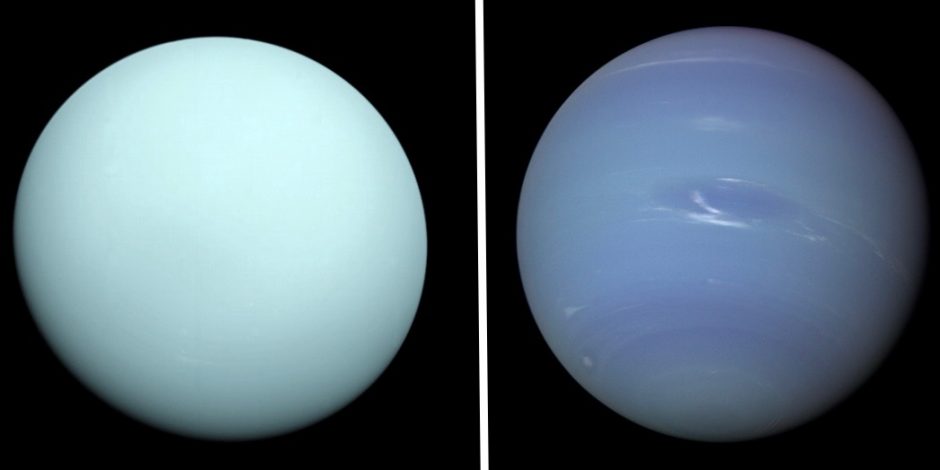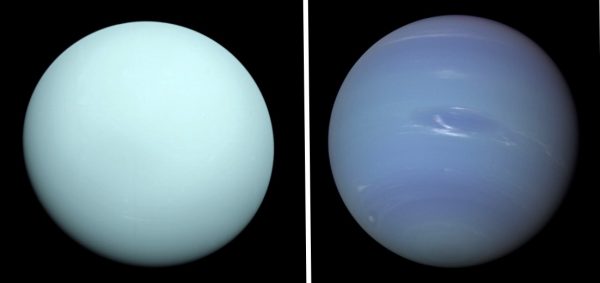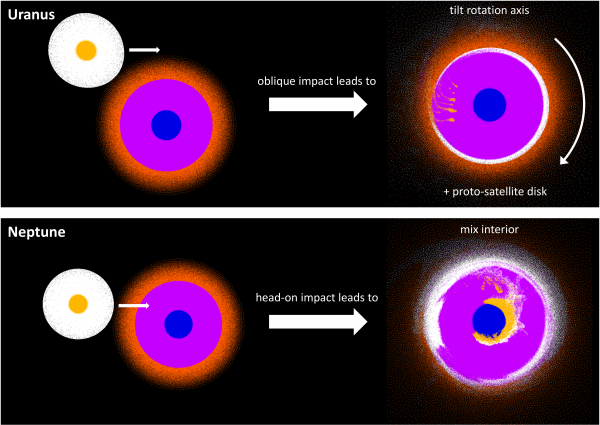Why Uranus and Neptune are different

The two outermost giant planets of the Solar system have similar masses but there are also striking differences. Researchers of the NCCR PlanetS at the University of Zurich have found an explanation for this long-standing unsolved mystery: Two different giant impacts could have had completely separate effects.
Uranus and Neptune are the outermost planets of the Solar system. In size, possibly bulk composition, and their large distance from the Sun they are similar and clearly segregated from the inner terrestrial planets and the gas giants Jupiter and Saturn. “However, there are also striking differences between the two planets that require explanation”, says Christian Reinhardt, who studied Uranus and Neptune together with Alice Chau, Joachim Stadel and Ravit Helled, all PlanetS members working at the University of Zurich, Institute for Computational Science. “For example, Uranus and its major satellites are tilted about 97 degrees into the Solar plane and the planet effectively rotates retrograde with respect to the Sun.” clarifies Joachim Stadel.
Also, the satellite systems are different. Uranus’ major satellites are on regular orbits and tilted with the planet, which suggests that they formed from a disk, similar to Earth’s Moon. Triton instead, Neptune’s largest satellite, is very inclined and therefore most likely a captured object. Finally, they could also be very different in terms of heat fluxes and internal structure.
Similar formation – different collisions
“It is often assumed that both planets formed in a similar way,” explains Alice Chau. This would readily explain their very similar masses, mean orbital separation from the Sun and possibly composition. But where do the differences come from? Since impacts are common during the formation and early evolution of planetary systems a giant impact was proposed as the origin of this dichotomy. But prior work either only investigated impacts on Uranus or was limited due to strong simplifications in the impact calculations.
For the first time, the team of scientists at the University of Zurich investigated a range of different collisions on both planets using high resolution computer simulations. Starting with very similar pre-impact Uranus and Neptune they showed that an impact of a body with 1-3 Earth masses on both planets can explain this dichotomy. In the case of Uranus, a grazing collision can tilt the planet but does not affect the planet’s interior.
On the other hand, a head-on collision for Neptune strongly affects the interior but does not form a disk, and is therefore consistent with the absence of large moons on regular orbits. Such a collision, which remixes the deep interior, is supported by the larger observed heat flux of Neptune. “We clearly show that an initially similar formation pathway to Uranus and Neptune can result in the dichotomy observed in the properties of these fascinating outer planets,” Ravit Helled summarizes. Future NASA and ESA missions to Uranus and Neptune can provide new key constraints on such a scenario, improve our understanding of the formation of the Solar System, and provide a better understanding of exo-planets in this mass regime.
Reference: Reinhardt et al.: Bifurcation in the history of Uranus and Neptune: the role of giant impacts, MNRAS, DOI: 10.1093/mnras/stz3271
Categories: News, Uncategorized



